Almería
Almería (UK: /ˌælməˈriːə/,[2] US also /ˌɑːl-/,[3][4] Spanish: [almeˈɾi.a]) is a city and municipality of Spain, located in Andalusia. It is the capital of the province of the same name. It lies on southeastern Iberia on the Mediterranean Sea. Caliph Abd al-Rahman III founded the city in 955.[5] The city grew wealthy during the Islamic era, becoming a world city throughout the 11th and 12th centuries.[6] It enjoyed an active port that traded silk, oil and raisins.[7]
Almería | |
|---|---|
Municipality | |
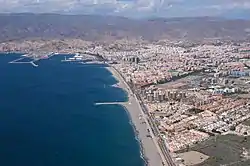 | |
 Flag  Coat of arms | |
| Motto(s): "Muy noble, muy leal y decidida por la libertad: ciudad de Almería" (Very noble, very loyal and determined towards freedom: city of Almería) | |
 Almería  Almería | |
| Coordinates: 36°50′25″N 2°28′05″W | |
| Country | |
| Region | |
| Province | Almería |
| Comarca | Comarca Metropolitana de Almería |
| Founded | 955 |
| Founded by | Abd-ar-Rahman III |
| Government | |
| • Body | Ayuntamiento de Almería |
| • Mayor | Ramón Fernández-Pacheco (PP) |
| Area | |
| • Total | 300 km2 (100 sq mi) |
| Elevation | 27 m (89 ft) |
| Population (2018)[1] | |
| • Total | 196,851 |
| • Density | 660/km2 (1,700/sq mi) |
| Demonyms | almerienses, urcitanos |
| Time zone | UTC+1 (CET) |
| • Summer (DST) | UTC+2 (CEST) |
| Postal code | 04001-04090 |
| Area code | (+34) 950 |
| Vehicle registration | AL |
| Website | http://www.aytoalmeria.es (in Spanish) |
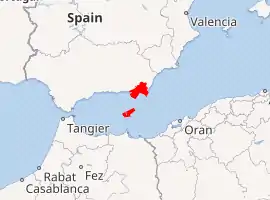 | |
| Click on the map for a fullscreen view | |
Etymology
The name "Almería" comes from the city's former Arabic name, Madīnat al-Mariyya, meaning "city of the watchtower".[8] As the settlement was originally port or coastal suburb of Pechina, it was initially known as Mariyyat al-Bajjāna (Bajjāna being the Arabic name for Pechina).[9]
History
The origin of Almería is connected to the 9th-century establishment of the so-called Republic of Pechina (Bajjana) some kilometres to the north, which was for a time autonomous from the Cordobese central authority: the settlement of current-day Almería initially developed as a humble trading port of Pechina known as Al-Mariyya Bajjana.[10] Pechina and its maritime port experienced divergent fortunes, and while the former progressively depopulated, the latter became the base of the Caliphal navy after 933, during the rule of Abd-ar-Rahman III.[11] Furthermore, in 955, Abd-ar-Rahman III decided to erect the walls.[12] A silk industry consisting of hundreds of looms and feeding itself from the mulberry trees planted in region, fostered Almería's economy.[13] Almería also became an important slave trade hub during the caliphal period.[14]
In the wake of the collapse of the Caliphate of Córdoba in the early 11th century, Almería detached from Cordobese authority towards 1014 and became ruled as an independent taifa under Slavic kinglets.[15] It submitted to the Taifa of Valencia in 1038, yet it soon became independent as a new taifa,[16] ruled by the Arab Banu Sumadih until 1091, when it fell to Almoravid control. This allowed the city's economy to insert itself into the trade networks of the Almoravid empire.[17] Building upon the previous development during the caliphal period, Almería reached a degree of historical relevance unmatched in the rest of its history throughout the 11th and 12th centuries,[18] becoming the third-largest city of Al-Andalus.[17] Almería imported indigo dye and wool from the Maghreb and linen from Egypt, while it exported copper to Fez and Tlemcen as well as its highly sought textiles.[14]
Contested by the emirs of Granada and Valencia, Almería experienced many sieges, including one especially fierce siege when Christians, called to the Second Crusade by Pope Eugene III, were also encouraged to counter the Muslim forces on a more familiar coast. On that occasion Alfonso VII, starting on 11 July 1147, at the head of mixed armies of Catalans, Genoese, Pisans and Franks, led a crusade against the rich city, and Almería was captured on 17 October 1147,[19] marking the breakup of the city's period of splendor in the Middle Ages.[20]
Within a decade, in 1157, Almería had passed to the control of Muslim Almohad rulers.[19] Almería soon passed by the temporary overarching control of rebel Murcian emir Ibn Mardanish (1165–1169), hindering the early efforts of recovery in the city,[21] that under the decade of Christian occupation reportedly had been left depopulated and, by and large, quite destroyed.[22] During Almohad rule, the city did not return to its previous splendor, although the port remained trading with the Crown of Aragon and the Italian republics.[23]
Following the rebellion against Almohad rule heralded by the likes of the Banu Hud and the Banu Mardanis, Almería submitted to the authority of Ibn Hud, who had raised the black banner and pledged nominal allegiance to Abbasid authorities by 1228.[24] After Ibn Hud's assassination in Almería in 1238,[25][23] the bulk of the remaining Muslim-controlled territories in the Iberian Peninsula passed to the control of rival ruler Ibn al-Aḥmar (sultan since 1232), who had set the capital of his emirate in Granada by 1238,[25] constituting the Emirate of Granada, to which Almería belonged from then on. While relatively languishing throughout the Nasrid period, Almería still remained a key strategic port of the emirate together with Málaga, as well as a haven for pirates and political dissidents.[26] It sustained intense trading relations with Aragon and the African port of Hunayn.[26] Almería endured a brutal siege by Aragonese forces in 1309 that, while eventually unsuccessful, left the city battered.[26]
The city submitted to the sovereignty of the Catholic Monarchs on December 22, 1489.[27] Relatively isolated and within the range of attacks from Barbary pirates, the hitherto mercantile city entered modernity by undergoing a process of heavy ruralization that imperiled its very same continued existence as a city.[28]
The 16th century was for Almería a century of natural and human catastrophes; for there were at least four earthquakes, of which the one in 1522 was especially violent, devastating the city. The people who had remained Muslim were expelled from Almería after the War of Las Alpujarras in 1568 and scattered across Spain. Landings and attacks by Barbary pirates were also frequent in the 16th century, and continued until the early 18th century. At that time, huge iron mines were discovered and French and British companies set up business in the area, bringing renewed prosperity and returning Almería to a position of relative importance within Spain.
.jpg.webp)
During the Spanish Civil War the city was shelled by the German Navy, with news reaching the London and Parisian press about the "criminal bombardment of Almería by German planes".[29] Almería surrendered in 1939, being the last Andalusian main city to fall to Francoist forces.
In the second half of the 20th century, Almería witnessed spectacular economic growth due to tourism and intensive agriculture, with crops grown year-round in massive invernaderos – plastic-covered "greenhouses" – for intensive vegetable production.
After Franco's death and popular approval of the new Spanish Constitution, the people of southern Spain were called on to approve an autonomous status for Andalusia region in a referendum. The referendum were approved with 118,186 votes for and 11,092 votes against in Almería province,[30] which represented 42% of all registered voters.[31]
Main sights
- The Alcazaba, a medieval fortress that was begun in the 10th century but destroyed by an earthquake in 1522. It includes a triple line of walls, a majestic keep and large gardens. It commands a city quarter with buildings dressed in pastel colors, of Muslim-age aspect. It is the second largest among the Muslim fortresses of Andalusia, after the Alhambra.
- Almería air raid shelters, underground galleries for civilian protection during the Spanish Civil War, currently the longest in Europe open for tourists.
- The Cathedral has a fortress-like appearance due to its towers, merlons and protected paths, created to defend it from Mediterranean pirates. Originally designated as a mosque, it was later converted into a Christian church, before being destroyed in the 1522 earthquake. In the 16th century it was rebuilt in the Renaissance style, whilst keeping some of its defensive features.
- Renaissance church of Santiago, built in 1533, with tower and portal decorated with reliefs.
- Chanca, a group of houses carved into rocks.
- Castle of San Cristobal, now in ruins. It is connected to the Alcazaba by a line of walls.
- Museum of Almería. Includes findings from Prehistoric, Iberic, Roman, Greek ages and Muslim objects, mostly from the Alcazaba.
- Paseo de Coches, a modern seaside promenade with gardens and palms.
- Cable Inglés (English Pier), 1904 iron railway pier built to transfer iron ore, copper, and silver produced by British- and French-run mines in Granada from trains to waiting cargo ships.
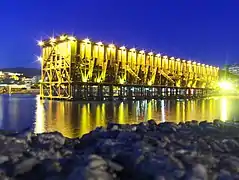 Cable Inglés, at night
Cable Inglés, at night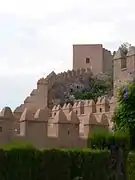 Alcazaba of Almería
Alcazaba of Almería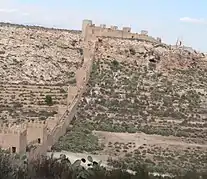 The ancient walls of Jayrán
The ancient walls of Jayrán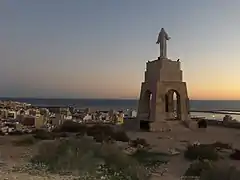 The statue of San Cristóbal
The statue of San Cristóbal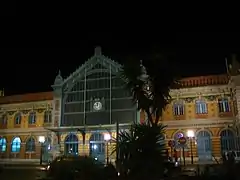 The former train station
The former train station
Demographics
Almería has the highest proportion of Muslim population of any Spanish city at 11-20%, depending on source.[32]
| Year | 1999 | 2001 | 2003 | 2005 | 2007 | 2009 | 2011 | 2012 | 2013 | 2014 | 2017 | 2018 | 2019 | 2020 |
|---|---|---|---|---|---|---|---|---|---|---|---|---|---|---|
| Population | 169,027 | 170,994 | 176,727 | 181,702 | 189,798 | 188,810 | 190,349 | 191,443 | 192,697 | 193,251 | 195,389 | 196,851 | 198,533 | 201,322 |
People and culture

Famous natives of Almería include Nicolás Salmerón y Alonso, who in 1873 was the third president of the First Spanish Republic, as well as several musicians, including the composer José Padilla Sánchez, whose music was declared of "universal interest" by Unesco in 1989, the popular folk singer Manolo Escobar, renowned Flamenco guitar player José Tomás "Tomatito" and Grammy Award winner David Bisbal; the champion motorcyclist Antonio Maeso moved to Almería as a child.
The Irish folk-rock group The Pogues paid tribute to Almería in "Fiesta," a song on the band's third album, If I Should Fall from Grace with God.
In 1989, English electronic band Depeche Mode filmed the video for their song "Personal Jesus" in Almería.
The tourism increased and hotels were all occupied from January to February during the filming of the sixth season of the TV series Game of Thrones.[33]
Sports
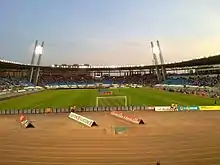
Almería hosted the Mediterranean Games in 2005. The city has 2 football teams: UD Almería, which was promoted to La Liga, the top tier of Spanish football, in 2022 and CP Almería, which plays in the División de Honor, the sixth tier.
The Plaza de toros de Almería is the main bullring in Almería. It has a capacity of 10,000 and it opened in 1882.
Economy

Intensive agriculture has been the most important economic sector of Almería for the last 50 years.[34] Nowadays, greenhouse's production, handling and commercialisation of vegetables, and the supply industry of the sector, represent almost 40% of Almería's GDP. Directly, agricultural production accounts for 18.2% of the provincial GDP. In Andalusia, the average contribution is 6.6% and in Spain it is only 2.9%.[35]
This situation is the result of a great dynamic model, which can continually incorporate new technologies: using soil sanding, plastic covers, drip irrigation systems, hybrid seeds, soil-less cultivation, irrigation programs, new greenhouse structures, and so on. They all allowed to improve production and increase commercialisation calendars, assuring the profitability and quality of the crops and the competitiveness of the markets.[36] Moreover, Almería's economy has an important exporting vocation:[37] 75% of production was sold abroad in 2018, with a value of 2.400 million euros.[38]
This development is explained by familiar investment, as subsidies have been limited or non-existent. In this sense, the horticultural sector receives the least European aids from the Common Agricultural Policy: 1.9% of total income. This figure is much lower than that received by other sectors such as olive groves (33%) or cereals (53%).[39]
The production of this area is based on a fair competition with officially a just remuneration of employees, with similar salaries than the ones in the same sector in Europe: 8% higher than Italy and 11% than Belgium.[40] This avoids the social dumping exerted by non-EU countries, like Morocco, with salaries up to 90% lower than those of Almería. However, there is well-documented widespread exploitation of workers from North Africa who work and live in terrible conditions, earning much lower than the minimum wage. [41]
From a social point of view, Almería and Granada are an example of familiar agriculture, with small farms and little concentration of land.[42] This social nature generates high equity in the level of income and welfare, that is, social cohesion is produced, and inequality is reduced.[43] Concretely, Almería is made up of 12.500 farms with an extension of 2,5 hectares and a 30% of familiar labour. It is also important the high education levels of the farmers, who shows an innovative and receptive character when it comes to continuing learning: 81,2% have some type of official academic training.[44]
At the same time, a commercial system based on social economy enterprises has been developed, e.g. as cooperative societies. These companies represent the 62% of production and sales.[45] They assure the access to the market in optimal conditions, because they increase its position inside the agri-food supply chain, facilitate financing, technical advice, and incorporation of technology. Moreover, local ties increase environmental sustainability.[46]
Transport
By land, Almería can be reached by the A-7 Mediterranean Highway, which connects the Mediterranean area with the Spanish A-92 that unites it with the rest of Andalusia. Almería railway station is served by Renfe Operadora with direct rail services to Granada, and Madrid Atocha using a branch off the Alcázar de San Juan–Cádiz railway; the Linares Baeza–Almería railway. In the future, high-speed rail AVE services will link Almería to Madrid via Murcia. The central railway station has been closed for several months and it is not known exactly when it will re-open. Passengers currently start their journey by being bussed a few kilometres to Huercal de Almería station.
By sea, the port of Almería has connections to Melilla, Algeria, Morocco, and tourist cruises in the Mediterranean. It also has a marina with moorings for pleasure boats. Currently the port of Almería is being expanded with new docks and transformed into a container port to take large-scale international shipping and thereby increase its freight traffic. It normally connects with the following destinations:
- Acciona: Ghazaouet (Algeria), Oran (Algeria), Nador (Morocco) and Melilla.
- Comarit: Nador.
- Comanav: Nador.
By air, Almería is served by Almería Airport, the fourth largest in Andalusia. The winter timetable includes flights to Madrid, Barcelona, Melilla, London, and Seville, with international connections to Manchester, Birmingham, Brussels, Dublin and Swiss, German and other EU airports being added during the summer.
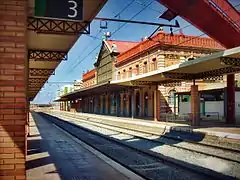 Almería rail station
Almería rail station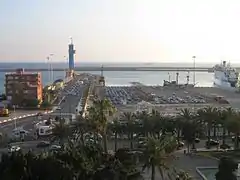 Harbour of Almería
Harbour of Almería
Geography
_Greenhouses_of_Almer%C3%ADa%252C_Spain_(cropped).jpg.webp)
Due to its arid landscape, numerous Spaghetti Westerns were filmed in Almería and some of the sets are still remain as a tourist attraction.[47][48] These sets are located in the desert of Tabernas. The town and region were also used by David Lean in Lawrence of Arabia (1962), John Milius in The Wind and the Lion (1975) and others.
One of Almería's most famous natural spots is the Cabo de Gata-Níjar Natural Park. This park is of volcanic origin,[49] and is the largest and most ecologically significant marine-terrestrial space in the European Western Mediterranean Sea. The Cabo de Gata-Níjar Natural Park runs through the municipal areas of Níjar, Almerimar and Carboneras. Its villages, previously dedicated to fishing, have become tourism spots. The beaches of Cabo de Gata-Níjar Natural Park are also an attraction.[50]
Almería has one islet that it administers as a part of its territory in the Alboran Sea, Alboran Island. The island has a small cemetery, a harbor, and a lighthouse, built in the 19th century.
Climate
With a yearly precipitation of just 200 mm (7.9 in) and with only 26 days of precipitation and an annual temperature of 19.1 °C (66.4 °F), Almería has a hot semi-arid climate (BSh) bordering on a hot desert climate (BWh) according to the Köppen climate classification, and it is the closest city in Europe to a hot desert climate, reaching it closely in the south-eastern outskirts of the city until the Cabo de Gata-Níjar Natural Park located east of the city. It is one of the driest zones on both shores of the Mediterranean coast.
The BWh climate is present in the city of Almería, in nearby areas of Almería province (such as the Cabo de Gata-Níjar Natural Park, the Andarax/Almanzora river valleys), the only region in Europe to have this climate (this excludes the Canary Islands, which are also part of Spain but geographically belong to the continent of Africa, which have a hot desert climate on most of the islands, specifically on the islands of Fuerteventura and Lanzarote in the Province of Las Palmas).[51] With an average annual temperature above 19.1 °C (66.4 °F), it also qualifies as the 3rd warmest city in continental Europe, after Seville and Athens. This arid climatic region spreads along the coastline around Almería to Torrevieja, in the northeast.[52] The nearby Faro del Cabo in the Cabo de Gata-Níjar Natural Park, has the lowest annual precipitation on the European continent (156mm).[53]
Almería also experiences the warmest winters of any city on the European continent with a population over 100,000, having hot and dry summers, with precipitation rare between June and August (July and August have in average 0.3 rainy days). Almería enjoys about 3,000 hours of sunshine with over 320 sunny days per year on average (6 hours of sunshine in January and 12 in July) so it is one of the sunniest cities in Europe.
Almería is unique, for a city in Continental Europe, for not having any registered temperature under the freezing mark in its recorded weather history. The coldest temperature recorded was 0.1 °C (32.2 °F) at the airport in January 2005.[54] Before that, the previous record was 0.2 °C (32.4 °F) on 9 February 1935.[55]
During the winter, daily maximum temperatures tend to stay around 17–18 °C (63–64 °F). At night, the minimum temperature is usually around 8–10 °C (47–50 °F). This makes Almería the city with the second warmest winters in Spain and Europe, just after Cádiz.[56] The city only receives 26 days of rainfall annually; so while no month could be described as truly wet, there are strong differences in terms of rainfall, with coastal parts of the city (such as the Cabo de Gata-Níjar Natural Park) receiving a rainfall amount of 156 mm (6.1 in) per year, which is also noted as the driest location in Europe, while inland areas (such as the Tabernas Desert) receive a rainfall amount of 200 mm (7.9 in) per year, since the average altitude is 600 m (2,000 ft), and it has an average temperature of 17.9 °C (64.2 °F), so it would be classified as a cold desert climate (BWk) bordering a cold semi-arid climate (BSk) according to the Köppen climate classification.
Inland areas of the Almería province are believed to have reached temperatures close to 50 °C (122 °F) in summer (dubious).[57] Perhaps, temperatures above 40 °C (104 °F) are very rare in the city of Almería.
During the warmest months - July and August, the sky is usually cloudless and almost no rainfall occurs. The typical daily temperatures are around 30 °C (86 °F) during the day while the minimum temperatures stay around 22 °C (72 °F) during July and August. As is the case for most of coastal Iberia, heatwaves in Almería are much less common than in the interior because of its coastal location; The hottest temperature recorded was 41.6 °C (106.9 °F) in July 2019.[58]
| Month | Jan | Feb | Mar | Apr | May | Jun | Jul | Aug | Sep | Oct | Nov | Dec | Year |
|---|---|---|---|---|---|---|---|---|---|---|---|---|---|
| Record high °C (°F) | 24.4 (75.9) |
25.7 (78.3) |
32.4 (90.3) |
34.2 (93.6) |
36.3 (97.3) |
40.8 (105.4) |
41.6 (106.9) |
41.1 (106.0) |
37.6 (99.7) |
34.4 (93.9) |
30.5 (86.9) |
29.2 (84.6) |
41.6 (106.9) |
| Average high °C (°F) | 17.0 (62.6) |
17.5 (63.5) |
19.4 (66.9) |
21.3 (70.3) |
24.3 (75.7) |
27.9 (82.2) |
30.5 (86.9) |
31.2 (88.2) |
28.2 (82.8) |
24.5 (76.1) |
20.3 (68.5) |
17.9 (64.2) |
23.4 (74.1) |
| Daily mean °C (°F) | 12.9 (55.2) |
13.4 (56.1) |
15.2 (59.4) |
17.1 (62.8) |
20.1 (68.2) |
23.6 (74.5) |
26.4 (79.5) |
27.2 (81.0) |
24.2 (75.6) |
20.6 (69.1) |
16.3 (61.3) |
13.9 (57.0) |
19.3 (66.7) |
| Average low °C (°F) | 8.7 (47.7) |
9.2 (48.6) |
10.9 (51.6) |
12.9 (55.2) |
15.8 (60.4) |
19.3 (66.7) |
22.3 (72.1) |
23.1 (73.6) |
20.2 (68.4) |
16.6 (61.9) |
12.4 (54.3) |
9.9 (49.8) |
15.1 (59.2) |
| Record low °C (°F) | 0.1 (32.2) |
0.7 (33.3) |
1.0 (33.8) |
2.7 (36.9) |
8.4 (47.1) |
10.4 (50.7) |
12.0 (53.6) |
14.8 (58.6) |
7.6 (45.7) |
3.4 (38.1) |
3.1 (37.6) |
2.0 (35.6) |
0.1 (32.2) |
| Average precipitation mm (inches) | 21.5 (0.85) |
24.2 (0.95) |
18.1 (0.71) |
15.3 (0.60) |
11.4 (0.45) |
6.1 (0.24) |
0.7 (0.03) |
2.4 (0.09) |
16.1 (0.63) |
27.0 (1.06) |
25.6 (1.01) |
31.6 (1.24) |
200 (7.86) |
| Average precipitation days (≥ 1 mm) | 2.9 | 2.7 | 3.1 | 2.7 | 1.7 | 0.6 | 0.2 | 0.3 | 1.9 | 3.3 | 3.3 | 3.1 | 25.8 |
| Mean monthly sunshine hours | 200 | 203 | 245 | 273 | 308 | 336 | 355 | 328 | 263 | 226 | 193 | 189 | 3,119 |
| Source: Météo Climat[59] | |||||||||||||
| Month | Jan | Feb | Mar | Apr | May | Jun | Jul | Aug | Sep | Oct | Nov | Dec | Year |
|---|---|---|---|---|---|---|---|---|---|---|---|---|---|
| Record high °C (°F) | 24.4 (75.9) |
25.7 (78.3) |
32.4 (90.3) |
34.2 (93.6) |
36.3 (97.3) |
40.8 (105.4) |
41.6 (106.9) |
41.1 (106.0) |
37.6 (99.7) |
34.4 (93.9) |
30.5 (86.9) |
29.2 (84.6) |
41.6 (106.9) |
| Average high °C (°F) | 16.9 (62.4) |
17.6 (63.7) |
19.6 (67.3) |
21.4 (70.5) |
24.1 (75.4) |
27.9 (82.2) |
30.5 (86.9) |
31.0 (87.8) |
28.4 (83.1) |
24.5 (76.1) |
20.5 (68.9) |
17.9 (64.2) |
23.4 (74.1) |
| Daily mean °C (°F) | 12.6 (54.7) |
13.3 (55.9) |
15.1 (59.2) |
17.0 (62.6) |
19.7 (67.5) |
23.5 (74.3) |
26.1 (79.0) |
26.7 (80.1) |
24.2 (75.6) |
20.4 (68.7) |
16.4 (61.5) |
13.8 (56.8) |
19.1 (66.4) |
| Average low °C (°F) | 8.3 (46.9) |
9.0 (48.2) |
10.6 (51.1) |
12.5 (54.5) |
15.3 (59.5) |
18.9 (66.0) |
21.7 (71.1) |
22.4 (72.3) |
20.0 (68.0) |
16.3 (61.3) |
12.3 (54.1) |
9.6 (49.3) |
14.7 (58.5) |
| Record low °C (°F) | 0.1 (32.2) |
0.7 (33.3) |
1.0 (33.8) |
2.7 (36.9) |
8.4 (47.1) |
10.4 (50.7) |
12.0 (53.6) |
14.8 (58.6) |
7.6 (45.7) |
3.4 (38.1) |
3.1 (37.6) |
2.0 (35.6) |
0.1 (32.2) |
| Average precipitation mm (inches) | 24 (0.9) |
25 (1.0) |
16 (0.6) |
17 (0.7) |
12 (0.5) |
5 (0.2) |
1 (0.0) |
1 (0.0) |
14 (0.6) |
27 (1.1) |
28 (1.1) |
30 (1.2) |
200 (7.9) |
| Average precipitation days (≥ 1 mm) | 2.9 | 2.9 | 2.6 | 2.6 | 1.9 | 0.6 | 0.3 | 0.3 | 1.5 | 2.8 | 3.6 | 3.3 | 25.4 |
| Average relative humidity (%) | 67 | 67 | 65 | 62 | 63 | 61 | 60 | 63 | 65 | 68 | 67 | 67 | 65 |
| Average dew point °C (°F) | 7 (45) |
7 (45) |
9 (48) |
10 (50) |
13 (55) |
16 (61) |
18 (64) |
20 (68) |
18 (64) |
15 (59) |
10 (50) |
8 (46) |
13 (55) |
| Mean monthly sunshine hours | 194 | 191 | 232 | 261 | 297 | 325 | 342 | 315 | 256 | 218 | 183 | 178 | 2,994 |
| Source 1: Agencia Estatal de Meteorología[60][61][62][63] | |||||||||||||
| Source 2: Time and Date (dewpoints, between 1985−2015)[64] | |||||||||||||
Crystal cave
In 2000, a team of geologists found a cave filled with giant gypsum crystals in an abandoned silver mine near Almería. The cavity, which measures 8 by 1.8 by 1.7 metres (26.2 ft × 5.9 ft × 5.6 ft), may be the largest geode ever found.[65] The entrance of the cave was blocked by five tons of rocks, and was under police protection (to prevent looters from entering). According to geological models, the cave was formed during the Messinian salinity crisis 6 million years ago, when the Mediterranean sea evaporated and left thick layers of salt sediments (evaporites). The site is currently open for tourists under guided tours.
Festivities
The festive events that occur in the municipality are listed below:[66]
- Carnival
- Holy Week
- Cruces de mayo
- Saint Joan's Eve
Notable people
- José Tomás "Tomatito" (born 1958), Flamenco guitar player.[67]
- Lita Baron (1923-2015), actress, singer and dancer. Was born in Almería.[68]
- David Bisbal (born 1979), Grammy Award winner.[69]
- Francisco Losada (1612-1667), composer.
- Nieves Navarro (born 1938), actress.[70]
- Manuel Lao Hernández, founder of Cirsa, Spain's largest casino operator
- Rosa García-Malea López (born 1981), first female fighter pilot in the Spanish Air Force
- Juan Martínez Oliver (born 1964), road bicycle racer.[71]
- Eduardo del Pino Vicente, journalist and writer.[72]
- Chus Lampreave (1930-2016), actress who died in Almería.[73]
- Jimena Quirós (1899 - 1983), Spanish scientist considered the first female oceanographer in the country and the first female staff scientist of the Spanish Institute for Oceanography (IEO) [74]
See also
- Solar Almeria Platform
References
- Municipal Register of Spain 2018. National Statistics Institute.
- "Almería". Lexico UK English Dictionary. Oxford University Press. Archived from the original on 2022-09-02.
- "Almería". The American Heritage Dictionary of the English Language (5th ed.). HarperCollins. Retrieved 27 July 2019.
- "Almería". Collins English Dictionary. HarperCollins. Retrieved 27 July 2019.
- García Martín, Fernando Miguel; Ros Sempere, Marcos; Martín García, Juan (2014). "Actuar en la ciudad consolidada. Resumen de un curso en Almería. Cartagena, Universidad Politécnica". Cuadernos de introducción a la urbanística-CIURB. 4. ISBN 978-84-942562-9-5.
- Mazzoli-Guintard 2016, p. 249.
- Valera Escobar, Ginés (6 February 2014). "La Almería musulmana". Diario de Almería.
- García-Pulido, Luis José (2019). "Almería art and architecture". In Fleet, Kate; Krämer, Gudrun; Matringe, Denis; Nawas, John; Rowson, Everett (eds.). Encyclopaedia of Islam, Three. Brill. ISBN 9789004386679. ISSN 1873-9830.
- Bosch-Vilá, J. (1960–2007). "al-Mariyya". In Bearman, P.; Bianquis, Th.; Bosworth, C.E.; van Donzel, E.; Heinrichs, W.P. (eds.). Encyclopaedia of Islam, Second Edition. Brill. ISBN 9789004161214.
- Sánchez Sedano 1985, p. 163.
- Sánchez Sedano 1985, pp. 163–164.
- Aziz Salem 1979–1980, p. 8.
- Sánchez Sedano 1985, p. 164.
- Mazzoli-Guintard 2016, p. 246.
- Viguera Molins 2014, pp. 29, 32.
- Viguera Molins 2014, p. 32.
- Mazzoli-Guintard 2016, p. 245.
- Mazzoli-Guintard 2016, p. 244.
- Rogers 2010, p. 36.
- Villanueva Muñoz 1981, p. 269.
- García López, José Luis; Cara Barrionuevo, Lorenzo; Ortiz Soler, Domingo (1990). "Características urbanas del asentamiento almohade y nazarí en la ciudad de Almería a la luz de los últimos hallazgos arqueológicos" (PDF). Almería entre culturas: (siglos XIII-XVI). Vol. 1. p. 99. ISBN 84-86862-43-4.
- García López, Cara Barrionuevo & Ortiz Soler 1990, p. 91.
- Molina López 1990, p. 20.
- Melo Carrasco 2019, p. 6.
- Melo Carrasco 2019, p. 7.
- Molina López 1990, p. 21.
- O'Callaghan, Joseph F. (2014). The Last Crusade in the West: Castile and the Conquest of Granada. Philadelphia: University of Pennsylvania Press. p. 180. ISBN 9780812245875; Vilá, Jacinto Bosch (1989). "Al-Mariyya". In Bosworth, C.E.; van Donzel, E.; Heinrichs, W.P.; Pellat, Ch. (eds.). Encyclopedia of Islam. Vol. IV. Leiden: E.J. Brill. p. 577. ISBN 9789004081185.
- Villanueva Muñoz, Emilio Ángel (1981). "La actuación en el casco antiguo de Almería durante el siglo XIX" (PDF). Boletín del Instituto de Estudios Almerienses. Letras (1): 269–270. ISSN 0211-7541.
- Abella, Rafael La vida cotidiana durante la guerra civil: la España republicana. p.254 Editorial Planeta 1975
- "Referéndum de ratificación de la iniciativa autonómica de Andalucía - Constitución española". Congreso.es. Retrieved 2012-08-02.
- "Referéndum del Estatuto de Andalucía - La Voz Digital". Servicios.lavozdigital.es. Retrieved 2012-08-02.
- "Islam in Spain". Euro-Islam. March 8, 2010. Retrieved February 15, 2018.
- Cuadrado, Fernando; Martínez, Evaristo (31 January 2016). "La industria del cine llena los hoteles de la capital". La Voz de Almería (in Spanish). Retrieved 3 June 2019.
- Galdeano, E.; Aznar-Sánchez, J.A.; Pérez-Mesa, J.C. (2013). ""Sustainability dimensions related to agricultural based-development: the experience of 50 years of intensive farming in Almería (Spain)"". International Journal of Agricultural Sustainability. 11 (2): 125–143. doi:10.1080/14735903.2012.704306. S2CID 153928568.
{{cite journal}}: CS1 maint: multiple names: authors list (link) - INE, Instituto Nacional de Estadística (2018). "Contabilidad regional de España". INE. Archived from the original on 2007-11-09.
- Molina, J.; García, R. (1999). El papel de la agricultura intensiva en la economía almeriense. Vida Rural. pp. 27–30.
{{cite book}}: CS1 maint: multiple names: authors list (link) - Aznar Sánchez, J. A.; Galdeano Gómez, E.; Godoy Durán, A.; Tapia León, J. J. (2013): “Caracterización y desafíos del sector de la comercialización”; en J. A. Aznar Sánchez (coord.) El sector de la comercialización hortícola en Almería (pp. 17-46). Ed. Caja Rural Intermediterránea, Cajamar. Almería.
- Cajamar (2018): “Análisis de la campaña hortofrutícola de Almería. Campaña 2016-2017”. Almería: Fundación Cajamar.
- European Union (2017): “Operating subsidies (both direct payments and rural development except investment support)”. En red: https://ec.europa.eu/agriculture/sites/agriculture/files/statistics/facts-figures/cap-operating-subsidies.pdf [Consultado: abril 2018]
- Livre Blanc (2017): “Les Producteurs de Légumes de France” En red: http://www.legumesdefrance.fr/sites/fnplegweb/livre_blanc_2017.pdf
- The Guardian (2020): “We pick your food': migrant workers speak out from Spain's 'Plastic Sea” En red: https://www.theguardian.com/global-development/2020/sep/20/we-pick-your-food-migrant-workers-speak-out-from-spains-plastic-sea
- IFAPA, Instituto de Investigación y Formación Agraria y Pesquera de Andalucía (2016): “El sistema de producción hortícola protegido de la provincia de Almería“. Online: http://www.juntadeandalucia.es/agriculturaypesca/ifapa
- Galdeano-Gómez, E.; Aznar-Sánchez, J.A.; Pérez-Mesa, J.C. (2016): “Contribuciones económicas, sociales y medioambientales de la agricultura intensiva de Almería”. Almería: Cajamar Caja Rural.
- IFAPA, Instituto de Investigación y Formación Agraria y Pesquera de Andalucía (2016): “El sistema de producción hortícola protegido de la provincia de Almería“. Online: http://www.juntadeandalucia.es/agriculturaypesca/ifapa
- COEXPHAL, Asociación de Organizaciones de Productores de Frutas y Hortalizas de Almería (2016): “Memoria 2015/16”. Online http://www.coexphal.es/descargas/
- Galdeano-Gómez, E.; Aznar-Sánchez, J.A.; Pérez-Mesa, J.C. (2016): “Contribuciones económicas, sociales y medioambientales de la agricultura intensiva de Almería”. Almería: Cajamar Caja Rural
- "Poblados del Oeste. Desierto de Tabernas". Parque Natural Cabo de Gata (in Spanish). Retrieved February 14, 2018.
- Frayling, Christopher (August 1, 2005). "'Once Upon A Time in Italy': The Films of Sergio Leone". NPR Books. Retrieved August 2, 2012.
- "Cabo de Gata-Níjar Nature Reserve in Spain | spain.info in english". Spain.info. Retrieved 2021-03-07.
- "Cabo de Gata-Níjar - Web oficial de turismo de Andalucía" (in Spanish). Archived from the original on 2020-09-23. Retrieved 2021-03-07.
- http://www.aemet.es/documentos/es/conocermas/recursos_en_linea/publicaciones_y_estudios/publicaciones/2Atlas_climatologico/Atlas_Clima_Macaronesia___Baja.pdf
- Atlas Climático Ibérico (PDF). Agencia Estatal de Meteorología (in Spanish). Ministerio de Medio Ambiente y Medio Rural y Marino. Gobierno de España. 2011. p. 80. ISBN 978-84-7837-079-5.
- Capel Molina, José Jaime (1995). "Mapa pluviométrico de España peninsular y Baleares (en el período internacional 1961-1990)" (PDF). Investigaciones Geográficas (in Spanish) (13): 29–46. doi:10.14198/INGEO1995.13.02. ISSN 0213-4691. Retrieved July 3, 2009.
- Agencia Estatal de Meteorología. "Almería: Almería Aeropuerto - Valores extremos absolutos - Selector - Agencia Estatal de Meteorología - AEMET. Gobierno de España".
- Agencia Estatal de Meteorología. "Almería: Almería - Valores extremos absolutos - Selector - Agencia Estatal de Meteorología - AEMET. Gobierno de España".
- "15 lugares de España para huir del invierno" (in Spanish). Skyscanner. 2017.
- "Extreme temperature records since 1850". Archived from the original on 2007-10-08. Retrieved 2015-04-10.
- "Almería Aeropuerto: Almería Aeropuerto - Valores extremos absolutos - Selector - Agencia Estatal de Meteorología - AEMET. Gobierno de España".
- "Météo climat stats Moyennes 1991/2020 Espagne (page 1)" (in French). Retrieved 14 June 2022.
- "Valores climatológicos normales. Almería Aeropuerto". Agencia Estatal de Meteorología. Ministerio de Medio Ambiente y Medio Rural y Marino. Gobierno de España.
- "Valores extremos. Almería Aeropuerto". AEMET. Retrieved 2 March 2021.
- "Guía resumida del clima en España (1981-2010) - Agencia Estatal de Meteorología - AEMET. Gobierno de España".
- "Valores extremos. Almería Almería Aeropuerto". Agencia Estatal de Meteorología. Ministerio de Medio Ambiente y Medio Rural y Marino. Gobierno de España.
- "Climate & Weather Averages at Almería Airport weather station". Retrieved 8 February 2022.
- Amos, Jonathan (June 12, 2000). "Giant crystal cave discovered". BBC News. Retrieved November 18, 2017.
- "Fiestas Almería Ciudad". Almería Turismo │Turismo e información de Almería ciudad (in Spanish). Retrieved 2020-09-15.
- Pita, Helena (June 20, 2017). "La guitarra de Tomatito". Radiotelevisión Española (in Spanish). Retrieved February 15, 2018.
- "Lita Baron (1923–2015)". IMDb. Retrieved 19 January 2021.
- Agencias (September 4, 2003). "David Bisbal, premio al "mejor nuevo artista" en los Grammy Latino". ABC (in Spanish). Miami, EEUU.
- "Nace en Almería la actriz Nieves Navarro García". Diario de Almería (in Spanish). November 10, 2017. Retrieved February 15, 2018.
- Delgado, Pedro (April 14, 2016). Las escapadas de Perico: Rutas en bici por España. Penguin Random House Grupo Editorial España. p. 256. ISBN 9788403515000.
- "Primer Concurso de micro guiones de cine". La Voz de Almería (in Spanish). March 16, 2018. Retrieved March 22, 2018.
- Martínez, Evaristo (4 April 2016). "Fallece en Almería Chus Lampreave". La Voz de Almería (in Spanish). Retrieved 13 September 2018.
- "Jimena Quirós: the first Spanish oceanographer". Tek Deeps. 2020-08-16. Retrieved 2021-03-28.
Notes
Sources
- Aziz Salem, Abdel (1979–1980). "Algunos aspectos del florecimiento económico de Almería islámica durante el período de los taifas y de los almorávides" (PDF). Revista del Instituto Egipcio de Estudios Islámicos (20): 7–22. ISSN 1132-3485.
- Mazzoli-Guintard, Christine (May 2016). "Almería, ¿ciudad-mundo en los siglos XI y XII?". Carolvs, Homenaje a Friedrich Edelmayer. Alcalá la Real: Ayuntamiento de Alcalá la Real. pp. 241–249. ISBN 978-84-89014-76-3.
- Melo Carrasco, Diego (2019). "El sultanato Nazarí de Granada y la frontera (S. XIII-XV)". Revista Encrucijada Americana. Santiago: Universidad Alberto Hurtado. 11 (2). ISSN 0719-3432.
- Molina López, Eduardo (1990). "Almería en la etapa Nasri (siglos XIII al XV). Estado de la cuestión, balance y perspectivas" (PDF). Almería entre culturas: (siglos XIII-XVI). Vol. 1. pp. 15–68. ISBN 84-86862-43-4.
- Rogers, Clifford J. (2010). The Oxford Encyclopedia of Medieval Warfare and Military Technology: Vol. 1. Oxford University Press. ISBN 978-0195334036.
- Sánchez Sedano, María del Pilar (1985). "Inventario de arquitectura musulmana en la provincia de Almería" (PDF). Boletín del Instituto de Estudios Almerienses. Letras (5): 163–188. ISSN 0211-7541.
- Viguera Molins, María Jesús (2014). "Los reinos de taifas y el reino aftasí" (PDF). In Zozaya Stabel-Hansen, Juan; Kurtz Schaefer, Guillermo S. (eds.). Estudios sobre el reino aftasí. Badajoz: Consejería de Educación y Cultura. Junta de Extremadura. ISBN 978-84-9852-429-1.